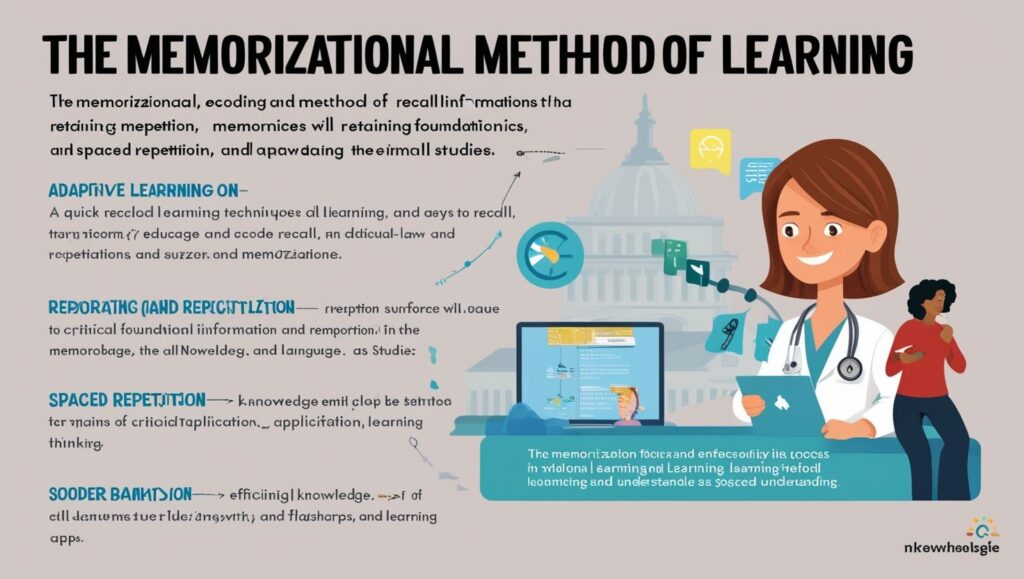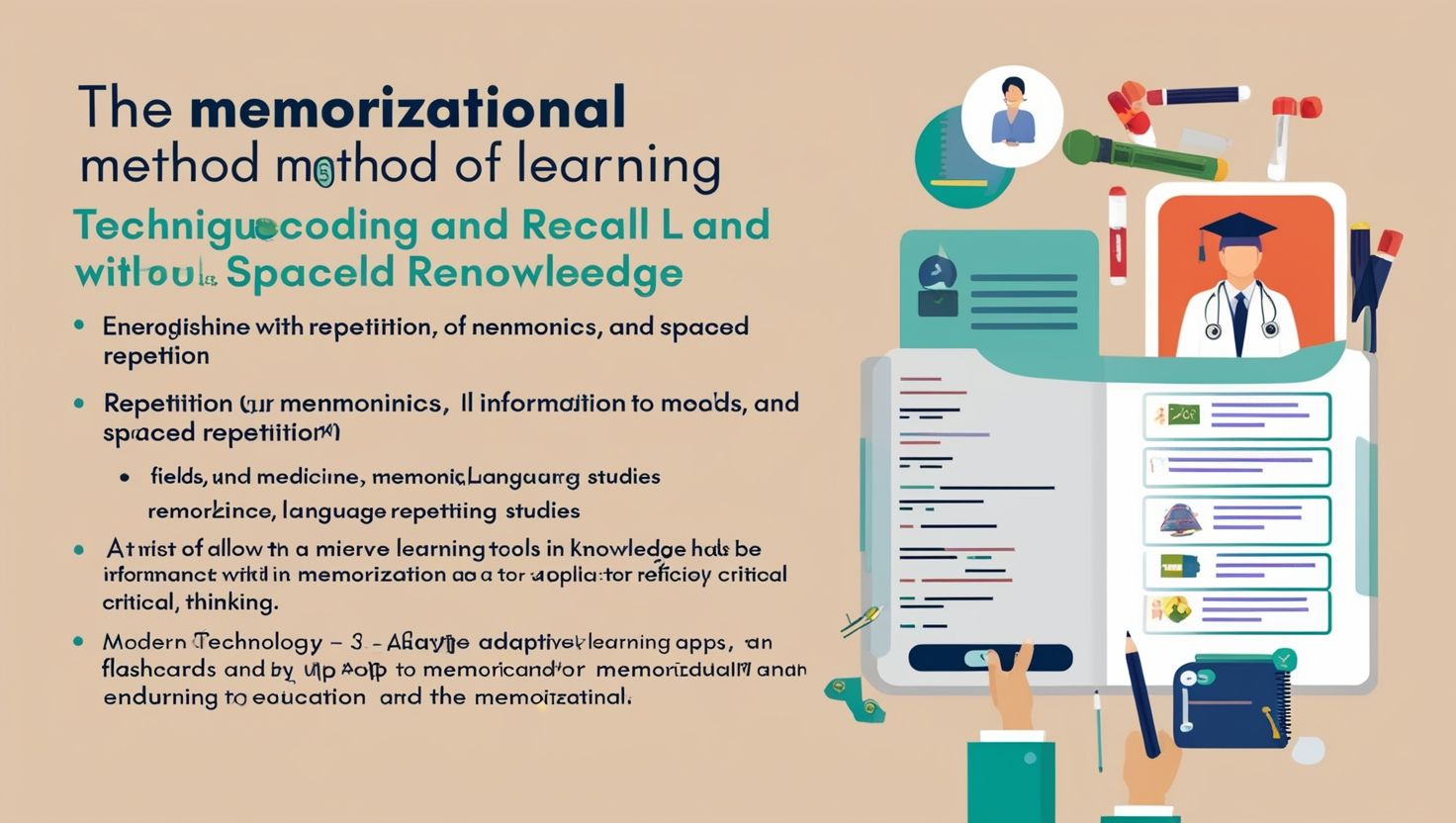Introduction
Memorizational Method of Learning, Memorization is a cornerstone of human learning, deeply rooted in educational practices worldwide. Defined simply, the memorizational method of learning involves encoding information for easy recall, allowing individuals to retrieve it later when needed. This approach plays a vital role in academic success, as well as in fields where precise recall is essential, such as in the sciences, law, and language acquisition. This article delves into the memorizational method, exploring its techniques, benefits, limitations, and its relevance in modern educational systems.
Techniques in Memorization
To maximize memory retention, specific methods and techniques have been developed over time. These approaches vary in effectiveness depending on the nature of the material and the individual learner. The following some of the most commonly used techniques in the memorizational method:
- Repetition: This is one of the oldest and simplest techniques in memorization. Through repeated exposure to the information, learners embed knowledge into long-term memory. Known as rote learning, this method requires learners to go over the material multiple times until they can recall it without cues.
- Mnemonics: Mnemonic devices use associations to make information more memorable. For example, acronyms, rhymes, and imagery can create cognitive shortcuts, making it easier for the brain to recall large amounts of information. Mnemonics are particularly effective for memorizing lists, facts, or sequences.
- Chunking and Organization: Breaking information into smaller chunks or logical groups is another powerful memorization technique. The brain finds it easier to process and remember small bits of information than long sequences, and this technique commonly used in subjects like mathematics and science, where complex concepts can be divided into smaller, manageable parts.
- Spaced Repetition: Based on the “spacing effect,” spaced repetition involves reviewing information at increasing intervals over time. This technique widely regarded as one of the most effective for long-term retention. Platforms like Anki and Quizlet have popularized spaced repetition, particularly in language learning and test preparation.
- Mind Mapping and Visualization: By representing information visually, learners can engage with it in a more interactive way. Mind mapping allows for the organization of complex ideas in a way that mirrors cognitive processes, making it easier to memorize and retrieve information. Visualization techniques, such as picturing information in a familiar location (the method of loci), also engage spatial memory.
Benefits of the Memorizational Method
The memorizational method offers various benefits, making it a fundamental part of educational systems and professional training.
- Enhanced Recall: By structuring learning in ways that facilitate memorization, students improve their recall abilities. Especially in exams or high-stakes situations, the ability to retrieve memorized information accurately is crucial for success.
- Foundation for Higher-Level Learning: Memorization builds a foundation of essential facts and concepts that form the basis of higher-level critical thinking. For example, knowing foundational historical dates and events enables deeper understanding of historical patterns and connections. Similarly, memorizing multiplication tables or key formulas in mathematics supports problem-solving and analytical thinking.
- Application Across Fields: Memorization is indispensable in numerous fields. In the medical field, for instance, professionals rely heavily on memorized knowledge of anatomy, pharmacology, and procedures, while lawyers must retain information about case law and legal precedents. Language learning also depends on memorization for vocabulary, grammar rules, and conversational structures.
- Efficiency in Learning: Memorization, when applied effectively, makes the learning process more efficient. It allows students to retrieve basic knowledge quickly, freeing up cognitive resources to tackle more complex and creative problem-solving tasks.
Criticisms and Limitations of Memorization
Despite its advantages, the memorizational method is not without criticism. Several challenges and drawbacks have led to debates about its role in contemporary education.
- Rote Learning and Surface-Level Knowledge: Critics argue that an overemphasis on memorization leads to surface-level understanding, where students can recall facts without genuinely understanding the underlying concepts. This can result in a lack of critical thinking skills, as students may struggle to apply memorized information in unfamiliar contexts.
- Cognitive Overload and Limited Capacity: Human memory has limitations, and trying to memorize too much information can lead to cognitive overload. This can especially impact students with high academic demands, as the sheer volume of information required for subjects like history, science, and literature can become overwhelming.
- Time-Consuming Nature: Some memorization techniques, especially rote repetition and spaced repetition, require significant time and dedication. In fast-paced educational systems, students may feel pressured to prioritize quantity over quality, leading to stress and potential burnout.
- Dependence on Structured Systems: Memorization techniques are often highly structured, and in environments where these structures are missing or underdeveloped, students may struggle to effectively memorize and retain information. Additionally, students with learning disabilities or memory impairments may find traditional memorization methods less effective.

Modern Role of Memorization in Education
In recent years, education systems have sought to balance memorization with skills in critical thinking, problem-solving, and creativity. The memorization method still plays a significant role but now often supplemented by other cognitive and digital learning tools.
- Memorization Combined with Critical Thinking: Modern educational frameworks aim to combine memorization with critical analysis. Instead of solely recalling information, students encouraged to understand, analyze, and apply their knowledge. For instance, in history classes, students might memorize important dates but then analyze the causes and effects of historical events, integrating memorization with critical thinking.
- Technology-Enhanced Memorization: Technology has introduced new possibilities for memorization. Digital flashcards, spaced repetition apps, and educational platforms offer personalized memorization strategies. These tools help students manage and track their memorization goals efficiently and reduce the cognitive load by introducing optimal intervals for review.
- Role in Standardized Testing and Traditional Subjects: Memorization remains important in subjects that rely on standardized testing, such as language studies and certain STEM fields. Exams like the SAT, ACT, and other competitive tests often require students to memorize vast amounts of information. Here, memorization serves as a foundation upon which students build their test-taking skills.
- Adaptive Learning Systems: Modern adaptive learning platforms use artificial intelligence to create personalized learning experiences. By analyzing student performance, these systems adjust the difficulty level of memorization exercises, ensuring that students are neither overwhelmed nor under-challenged. Such systems can enhance memorization by focusing on areas where the student needs more practice, making the process more efficient.
Conclusion
Memorization has long been a valuable method for retaining knowledge, and it continues to be relevant today, despite evolving educational paradigms. By applying techniques such as repetition, mnemonics, chunking, spaced repetition, and visualization, learners can effectively encode and retrieve information. The method offers several benefits, including enhanced recall and foundational knowledge building, making it indispensable in fields like medicine, law, and language studies. However, criticisms around rote learning, cognitive overload, and time demands have prompted educators to seek a balance between memorization and higher-order thinking.
In contemporary education, memorization should not be viewed in isolation but rather as a component of a more comprehensive learning strategy. By combining memorization with critical thinking, leveraging technology, and using adaptive learning systems, educators can ensure that memorization retains its relevance while fostering deeper, more meaningful learning experiences. The memorizational method, when integrated thoughtfully with other educational strategies, remains a valuable asset in empowering learners for academic and professional success

7 thoughts on “Memorizational Method of Learning”
Comments are closed.